How To Create An Inventory Database In Sql
by Richard
How to Make an Awesome Inventory Management Application in PHP and MySQL

You do not need bloated enterprise software to effectively track your inventory. This tutorial will help you develop your own custom inventory tracking application so you can make smart inventory decisions based on timely and accurate inventory data.
System Requirements
Our Inventory System requires the standard commercial phpGrid and phpChart license. It needs a few advanced features from both components.
- PHP 5.6+(PHP 7.x is now highly recommended!)
- MySQL / MariaDB
- phpGrid Lite (subgrid) -or- phpGrid Enterprise (Master detail, Grouping)
- phpChart (for reports)
What is in an Inventory Management System
An inventory management system has several critical components. At its core, inventory control works by tracking the two main functions of a warehouse: receiving (incoming) and shipping (outgoing). Other activities such as the movement or relocation of inventory also take place. Raw materials are decremented and finished goods are incremented.
- Incoming shipments
- Outgoing orders
- Inventory
- Suppliers
- Barcode scanner (1/2019 New!)
Inventory System Database Design
Typically, an inventory system has four basic elements: products, purchases, orders, and suppliers. Each element must be tracked based on its location, SKU, and quantity. Current inventory, or products on hand, is updated by tracking incoming shipments and outgoing orders. Order alerts can be set to trigger when inventory levels fall below custom-defined minimum levels.

Setting up the Inventory Manager Database
Download the InventoryManager.sql SQL script from this tutorial's GitHub repo, and then execute the script using a MySQL tool such as MySQL Workbench. This will create a new database named InventoryManager as well as the tables needed for this tutorial.
A Side Note on ZenBase
The Inventory Management System is also one of the many application templates readily available at ZenBase (built on the top of phpGrid) for anyone — with or without coding skills — to use and customize for their own needs. Set up phpGrid
Let's move on.
We will use a datagrid component by phpGrid to handle all internal database CRUD (Create, Remove, Update, and Delete) operations.
Be sure to download a copy of phpGrid before you proceed.
To install phpGrid, follow these steps:
- Unzip the phpGrid download file.
- Upload the
phpGridfolder to the phpGrid folder. - Complete the installation by configuring the
conf.phpfile.
Before we begin coding, we must include the following information in conf.php , the phpGrid configuration file.
Creating the User Interface (UI)
Our inventory system comprises four pages:
- Current Inventory
- Incoming Purchases
- Orders to Ship
- Reports
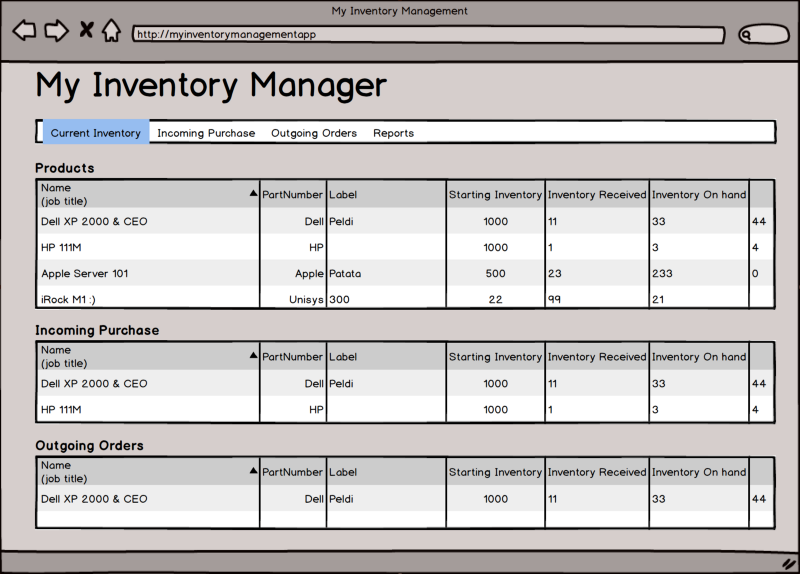
The include file for the menu is stored in an inc folder named menu.php . The code for the menu is straightforward. For the sake of focus, we will not go into great detail. Feel free to look at the code inside the inc folder.
We have also added a menu item named Reports.

Pages
We will use the same page template we used for the CRM and Project Management tutorials.
Current Inventory

Let's start with the Current Inventory page.
Incoming purchases increase the inventory while outgoing orders decrease it. From a master-detail perspective, the Current Inventory has not one, but two detail datagrids — the Purchases (incoming purchases) and the Orders (outgoing orders).
So the Current Inventory page is composed of one master grid (the Current Inventory in stock) and two detail grids (Incoming Purchases and Outgoing Orders). We can easily present these relationships using the phpGrid one master and multiple detail datagrids feature.
phpGrid Lite vs. Professional and Enterprise
Master detail and Grouping features require phpGrid Professional or Enterprise edition. If you are on the free Lite version, you can still use subgrid in place of Master detail albeit less advanced. Professional or Enterprise versions are highly recommended.
If you have read the last tutorial Building a Donation Manager from Scratch, you will have no problem following the code below.
Note the use of the set_col_format() function used to format the integers.
That's it for the Current Inventory datagrid. Here's what it looks like so far:

Now, let's make a few changes to enhance our Product datagrid.
First of all, we will add some conditional formatting: whenever the InventoryOnHand is set to zero or a negative value, it is displayed using a different background color. We will use the set_conditional_format() function for this purpose.
The above code adds a display condition so that whenever the InventoryOnHand field has a value that is less than (lt) one, the text color changes to red and the background color to dark gray (#DCDCDC).
Secondly, whenever the InventoryOnHand is less than the value shown in MinimumRequired, we would like to alert the user by displaying it in a prominent background color such as gold. To compare values between two fields, we must switch to Javascript because the set_conditional_format() function only works with a single field.
The code below uses a for loop to iterate through each row in the Products datagrid. It compares the inventoryOnHand with theminimumRequired and, when the condition is met, it will use thesetCell function to change the background color.
You can learn more about comparing multiple cell values on the phpGrid support website.
Next, on the same page, we need to see the purchases coming in (Incoming) and orders going out (Outgoing) for a specific product.
Purchases Detail Grid (Incoming)
Orders Detail Grid (Outgoing)
Both detail grids use the same foreign key ProductId to link to the master datagrid (Products).
Finally, our complete code to manage the Current Inventory page is:
Here's the a snapshot of the inventory page:
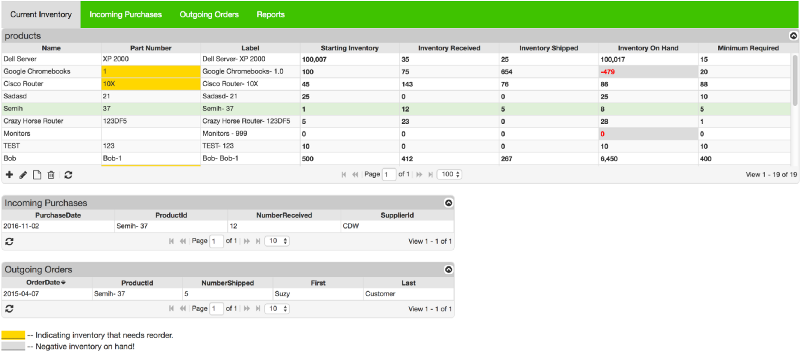
Incoming Purchases

The next page is the Incoming Purchase page. It is similar to the Purchase Detail Grid we saw when setting up the Current Inventory page. We group the purchases by ProductId and display the sum inNumberReceived. Any incoming purchases will increase the inventory.
Note: Grouping feature is only available in the phpGrid Professional and Enterprise edition. To filter without the grouping, use the integration search.
The complete code:
Here's a screenshot of our Incoming Purchases page with grouping enabled:
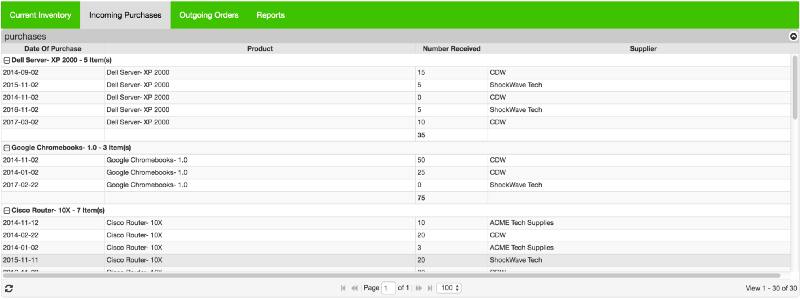
Outgoing Orders

The next page is the Outgoing Orders page. It is similar to the Orders Detail Grid from the Current Inventory page. Here, we will introduce an advanced function called set_grid_method().
Summary
This tutorial builds a simple and extendable inventory system in less than 50 lines of code. The progressive style of these tutorials also helps the reader to ultimately become more familar and comfortable with phpGrid by introducing a limited number of new phpGrid features in each one.
What's Coming Up
This marks the end of the code needed to create the datagrids required for this tutorial. However, we are not done yet. There is still one more page we need to create — Reports. We will cover that after the jump.
What's the use of an inventory system without some of type of report? In this section, you will learn how to use phpChart — which seamlessly integrates with phpGrid — to create visually pleasing and useful reports for your Inventory Manager application.
Here's what our page will look like when it's done:
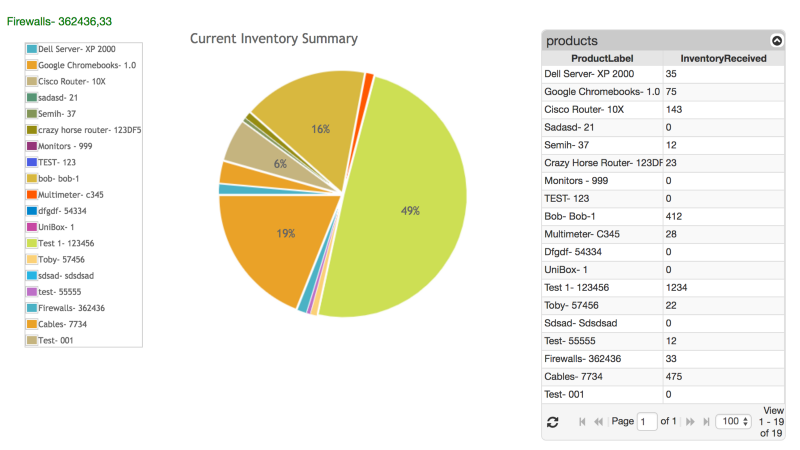
Before we start, we need to install phpChart. It is recommended that you obtain the full version of phpChart since the free version (phpChart Lite) supports only the line chart.
Setup phpChart
It's important that we keep phpGrid and phpChart in separate folders. Below is the recommended folder hierarchy.
www +-- Donation_Manager | |-- phpGrid | | +-- conf.php | |-- phpChart | | +-- conf.php | +-- ... Report Design
We will place a pie chart next to an inventory summary grid. The datagrid provides the series data to plot the pie chart.
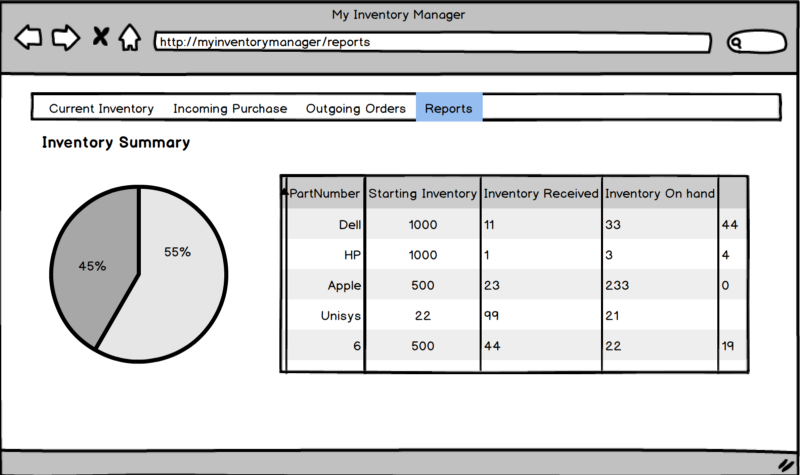
phpGrid and phpChart Integration
First of all, include calls to both conf.php files at the beginning of the code.
require_once("phpGrid/conf.php"); require_once("phpChart/conf.php"); Pie Chart
Below is the complete code to create our pie chart:
Let's walk through the code.
The first line is the constructor. We pass array(null) as the series data because we don't wish to have any data displayed in the pie chart initially. The inventory data used to plot the chart is not yet available when it is first initialized. The data is fed from the datagrid later in JSON.
We also give our chart a unique name, PieChart.
Next, we give it a title. Nothing fancy here.
Once we have the title, we call the series default function to set the renderer to PieRenderer. Unlike a bar chart, a pie chart does not have a Y axis.
We can also set the rendererOptions property. We will not go into each option in detail here, but you can find more information in the online documentation.
We also want to show a legend. The set_legend command below shows the legend to the west (noted byw) or to the left of the pie chart.
We will also remove the border and the background.
Finally, we draw our chart by giving it a height and width in pixels.
However, if you execute the code now, you will not see the chart because the data used to render it isn't available yet.
Inventory Summary Datagrid
Here, we will use the same the inventory datagrid as we did in the Products page. We just need to add one more thing — an event handler.
In phpGrid, we can add an event handler with the add_event() function. add_event() binds an event handler, which is essentially a JavaScript function, to a specific phpGrid event. A list of possible events can be found here.
Since we must wait for the datagrid to finish loading before it can send the data to plot the chart, we use the event jqGridLoadComplete.
phpGrid 101 — jqGridLoadComplete Event
jqGridLoadComplete is last event that occurs once the whole datagrid body has finished loading. Note that the grid body will be reloaded if the user changes the sort order of a column or sets a filter.
Sending Data with Javascript
The following is the Javascript event handler for jqGridLoadComplete.
The complete code:
Now there you have it. Your just built your very first inventory management system from scratch using PHP and MySQL!
Thank you for reading! If you enjoyed this post, please give me some claps so more people see it.
New to Programming? Fear Not!
If you are new to programming and are not yet comfortable with coding, you may want to check out ZenBase that is built on the top of the phpGrid. The Inventory Management System is but one of the many application templates readily available at ZenBase for anyone — with or without coding skills — to use and customize for their own needs.
Online Demo
- Current Inventory
- Incoming Purchases
- Outgoing orders
- Reports (with datagrid side-by-side)
Next: Add the barcode scanner
Add the barcode scanner to our inventory management system

Download Source Code on Github
phpcontrols/inventory-manager
Source code of inventory-manager the awesome Inventory Management Application in PHP and MySQL from Start to Finishgithub.com
Common Issue:
Fatal error: Uncaught Error: Class 'phpGrid\C_DataGrid' not found
How to fix:
If you are using the free Lite version, you can either comment out the first line
// use phpGrid\C_DataGrid; — OR —
Add a global namespace symbol — single backslash — BEFORE the constructor
$dg = new \C_DataGrid("SELECT * FROM orders", "orderNumber", "orders"); You may be also interested in those tutorials:
Build a Project Management Application From Scratch
What is a Project Management Application? Build a Simple CRM from Start to Finish
Customer Relationship Management (CRM) is a system that manages customer interactions and data throughout the customer… Building a Donation Manager from Scratch in PHP
Thanks for reading. If you enjoyed this article, please hit that clap button ? to help others find it and follow me on Twitter.

Learn to code for free. freeCodeCamp's open source curriculum has helped more than 40,000 people get jobs as developers. Get started
How To Create An Inventory Database In Sql
Source: https://www.freecodecamp.org/news/making-an-awesome-inventory-management-application-in-php-and-mysql-from-start-to-finish-90bc5996680a/
Posted by: ozunaparch2000.blogspot.com

0 Response to "How To Create An Inventory Database In Sql"
Post a Comment